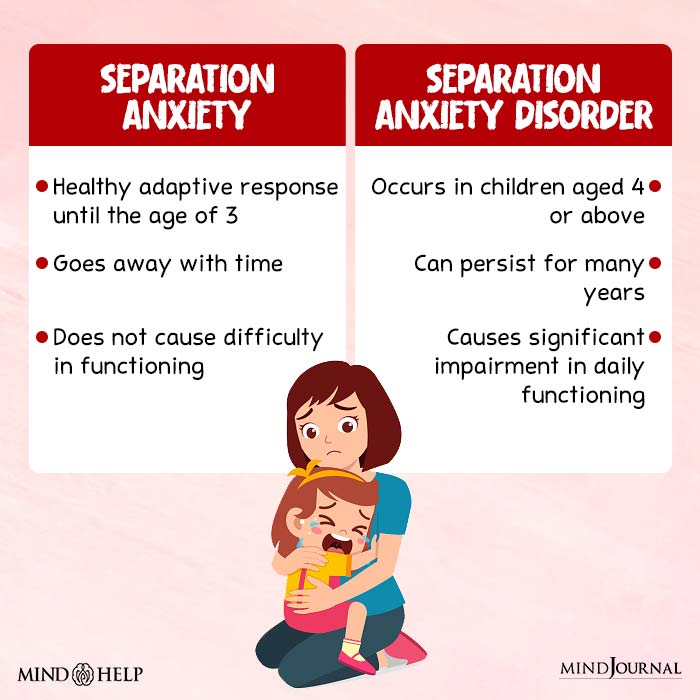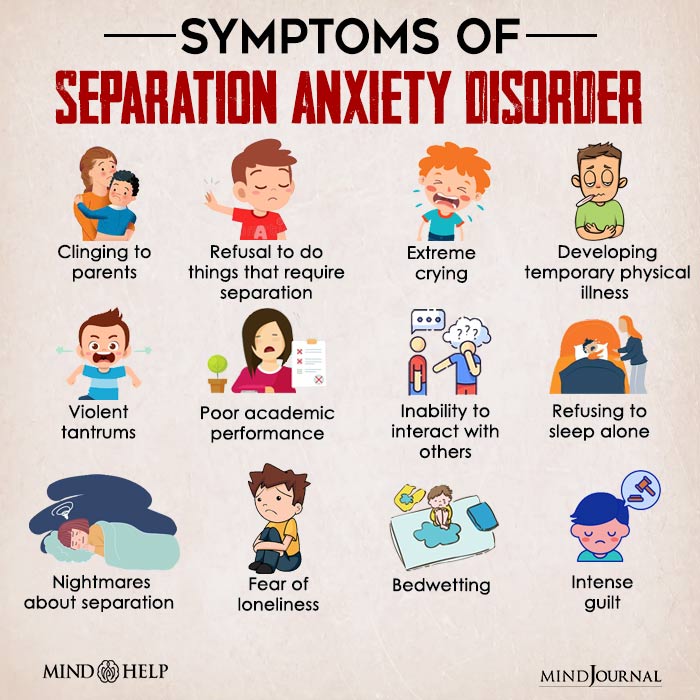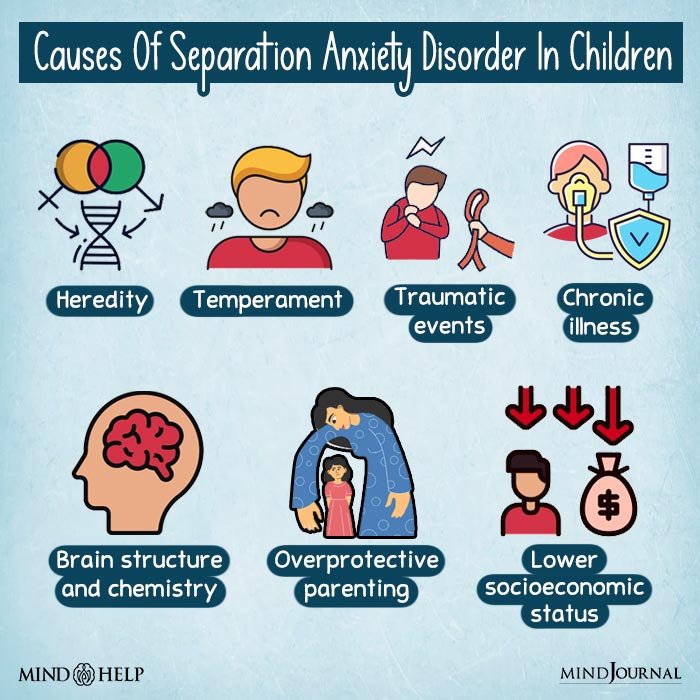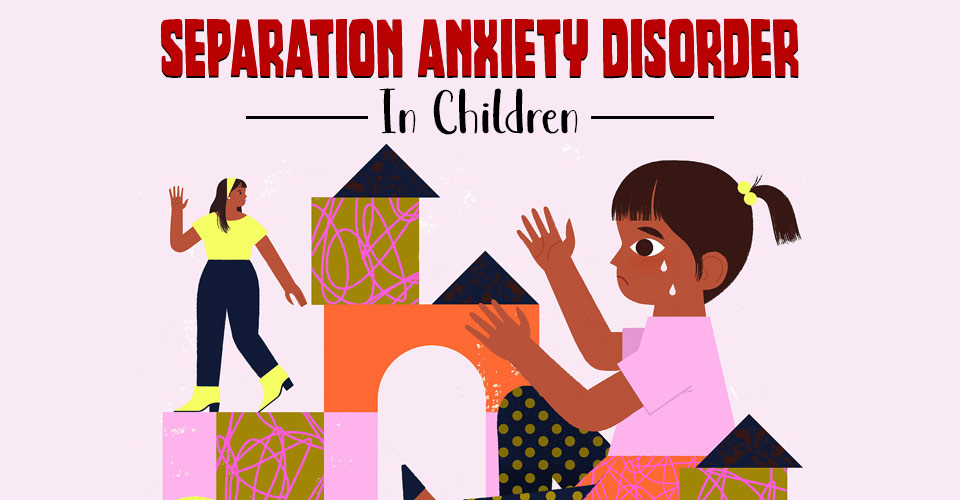Table of Contents
Separation anxiety disorder is a mental disorder that usually occurs in children, wherein they become fearful or anxious when they are away from home or separated from their caregivers.
What Is Separation Anxiety Disorder?
Separation anxiety disorder is a very common childhood anxiety disorder [mfn] Feriante, J., & Bernstein, B. (2020). Separation Anxiety. PubMed; StatPearls Publishing. https://www.ncbi.nlm.nih.gov/books/NBK560793/ [/mfn] characterized by excessive worry and dread due to separation from a caregiver or attachment figure. Here, an attachment figure refers to any person, usually an adult, that the child spends most of their time with and is therefore attached to. Separation anxiety disorder can significantly impair a child’s social and emotional development.
According to research, [mfn] Walker, L. S., Beck, J., & Anderson, J. (2009). Functional abdominal separation anxiety: helping the child return to school. Pediatric annals, 38(5), 267–271. [/mfn] separation anxiety disorder occurs in about 3–4% of children. However, there appears to be significant cultural variation in the prevalence of this disorder. Studies suggest [mfn] Bögels, S. M., Knappe, S., & Clark, L. A. (2013). Adult separation anxiety disorder in DSM-5. Clinical psychology review, 33(5), 663–674. https://doi.org/10.1016/j.cpr.2013.03.006 [/mfn] that it occurs more in western societies than in eastern ones.
Separation Anxiety Vs. Separation Anxiety Disorder

Separation anxiety is considered to be a healthy adaptive response in infants between 6 months and 3 years of age, and sometimes even until 4 or 5 years. [mfn] Ehrenreich, J. T., Santucci, L. C., & Weiner, C. L. (2008). SEPARATION ANXIETY DISORDER IN YOUTH: PHENOMENOLOGY, ASSESSMENT, AND TREATMENT. Psicologia conductual, 16(3), 389–412. https://doi.org/10.1901/jaba.2008.16-389 [/mfn] Although the intensity may vary, it usually goes away with time.
When separation anxiety persists for many years, it is likely to turn into a disorder. The primary difference between normal separation anxiety and separation anxiety disorder in children is the intensity of fear when the caregiver is out of sight and to what extent it interferes with their normal functioning.
In the case of the latter, the fear of separation tends to interfere with the daily activities of the child, like going to school or playing with other children.
Studies [mfn] Last, C. G., Francis, G., Hersen, M., Kazdin, A. E., & Strauss, C. C. (1987). Separation anxiety and school phobia: a comparison using DSM-III criteria. The American journal of psychiatry, 144(5), 653–657. https://doi.org/10.1176/ajp.144.5.653 [/mfn] have estimated that almost 75% of children with this disorder exhibit some form of ‘school refusal’ behavior. They also tend to face more obstacles at school than their peers.
Case study
Consider the case of Pooja, an only child who had been homeschooled until the age of 6. Ever since Pooja was born, there was hardly a moment where she was out of her mother’s sight.
Having once suffered an unfortunate miscarriage, Pooja’s parents had always been extremely concerned for her safety and as a result, quite protective of her. This was primarily why they had decided against sending her to preschool.
When she was finally admitted to a school at the age of 7, a usually cheerful Pooja started throwing tantrums at home every day, refusing to leave her mother. Soon, she started having recurring nightmares about her parents leaving her in school and not coming back to pick her up.
Multiple times a week, Pooja would wake up crying in the middle of the night and refuse to sleep alone. Her teachers too reported that she would bawl her eyes out most of the time at school and sometimes even throw up after excessive crying.
Pooja’s parents were now more concerned than ever and decided to consult a child psychologist. As it turned out, she had been suffering from separation anxiety disorder.
Separation Anxiety Disorder Symptoms
A child should gradually be able to separate and grow independent from their parental figures with age. It is important to notice if and when a child exhibits separation anxiety past the developmental age.
The symptoms [mfn] Patel, A. K., & Bryant, B. (2021). Separation Anxiety Disorder. JAMA, 326(18), 1880. https://doi.org/10.1001/jama.2021.17269 [/mfn] commonly associated with this disorder include:
- Temper tantrums as a result of separation from attachment figures
- Fear of losing their caregivers or some harm coming to them
- Refusal to go to school due to fear of separation
- Fear of being alone at home
- Refusal to sleep away from any attachment figure
- Nightmares involving separation
Separation anxiety disorder can also have certain physical manifestations such as:
- Headache
- Nausea
- Vomiting
- Stomachache
- Bed-wetting, etc.

Separation Anxiety Disorder In Adults
Although mostly diagnosed in children, several studies suggest that separation anxiety disorder can also occur in adults. However, it is not yet recognized as a separate category for an official diagnosis.
Separation anxiety disorder in adulthood can be associated with panic disorder and may also have limited comorbidity with dependent personality disorder [mfn] Manicavasagar, V., Silove, D., & Curtis, J. (1997). Separation anxiety in adulthood: a phenomenological investigation. Comprehensive psychiatry, 38(5), 274–282. https://doi.org/10.1016/s0010-440x(97)90060-2 [/mfn]. As per research, separation anxiety disorder symptoms in adults can have slightly different manifestations.
Causes Of Separation Anxiety Disorder
A combination of genetic, cognitive, and psychosocial factors may contribute to the development of separation anxiety disorder. Some of its most common causes are mentioned below:

1. Biological Factors
Separation anxiety disorder has been associated with factors relating to genes and brain chemistry.
1.1 Genetics
Separation anxiety disorder has been found to have a significant genetic predisposition [mfn] Silove, D., Manicavasagar, V., O’Connell, D., & Morris-Yates, A. (1995). Genetic factors in early separation anxiety: implications for the genesis of adult anxiety disorders. Acta psychiatrica Scandinavica, 92(1), 17–24. https://doi.org/10.1111/j.1600-0447.1995.tb09537.x [/mfn]. Studies [mfn] Bolton, D., Eley, T. C., O’Connor, T. G., Perrin, S., Rabe-Hesketh, S., Rijsdijk, F., & Smith, P. (2006). Prevalence and genetic and environmental influences on anxiety disorders in 6-year-old twins. Psychological medicine, 36(3), 335–344. https://doi.org/10.1017/S0033291705006537 [/mfn] have estimated heritability to be around 73%, with higher rates in females.
1.2 Neurology
Certain neurobiological markers [mfn] Schiele, M. A., Bandelow, B., Baldwin, D. S., Pini, S., & Domschke, K. (2020). A neurobiological framework of separation anxiety and related phenotypes. European neuropsychopharmacology : the journal of the European College of Neuropsychopharmacology, 33, 45–57. https://doi.org/10.1016/j.euroneuro.2020.01.009 [/mfn] associated with separation anxiety disorder include:
- Variations in neurotransmitters such as oxytocin, serotonin, opioid receptors, dopamine, etc.
- Dysregulation of the HPA axis
- Dysfunction of the cortico-limbic system
- Hypersensitivity to carbon dioxide, etc.
2. Psychosocial Factors
Several psychological and developmental causes tend to influence the onset and progression of separation anxiety disorder.
2.1 Temperament
A child’s temperament can act as a significant factor leading to long-term separation anxiety. Children who have a high “behavioral inhibition” [mfn] Pini, S., Abelli, M., Costa, B., Schiele, M. A., Domschke, K., Baldwin, D. S., Massimetti, G., & Milrod, B. (2022). Relationship of behavioral inhibition to separation anxiety in a sample (N = 377) of adult individuals with mood and anxiety disorders. Comprehensive psychiatry, 116, 152326. https://doi.org/10.1016/j.comppsych.2022.152326 [/mfn] especially experience higher levels of anxiety when they are not familiar with a particular location or people.
2.2 Paternal absence
Studies have found the absence of a father to significantly influence vulnerability to separation anxiety, especially in girls [mfn] Cronk, N. J., Slutske, W. S., Madden, P. A., Bucholz, K. K., & Heath, A. C. (2004). Risk for separation anxiety disorder among girls: paternal absence, socioeconomic disadvantage, and genetic vulnerability. Journal of abnormal psychology, 113(2), 237–247. https://doi.org/10.1037/0021-843X.113.2.237 [/mfn].
2.3 Parenting style
An analysis [mfn] Fox, A. S., & Kalin, N. H. (2014). A translational neuroscience approach to understanding the development of social anxiety disorder and its pathophysiology. The American journal of psychiatry, 171(11), 1162–1173. https://doi.org/10.1176/appi.ajp.2014.14040449 [/mfn] found that children are likely to develop this condition with parents who are also diagnosed with a psychological disorder. Mothers who have had adverse experiences—such as maltreatment and severed attachments with their own caregivers—tend to continue the trauma cycle with their own children.
2.4 Traumatic events
Separation anxiety disorder can develop due to stressful life events in childhood, such as the loss of a pet or a loved one, parental divorce, etc. Other environmental factors [mfn] Waszczuk, M. A., Zavos, H. M., & Eley, T. C. (2013). Genetic and environmental influences on relationship between anxiety sensitivity and anxiety subscales in children. Journal of anxiety disorders, 27(5), 475–484. https://doi.org/10.1016/j.janxdis.2013.05.008 [/mfn] include changes in schools/neighborhoods/countries, natural disasters, and other events that may force children to be separated from parental or caregiver figures.
Studies [mfn] Manicavasagar, V., & Silove, D. (1997). Is there an adult form of separation anxiety disorder? A brief clinical report. The Australian and New Zealand journal of psychiatry, 31(2), 299–303. https://doi.org/10.3109/00048679709073835 [/mfn] also reveal that separation anxiety disorder in adults is triggered by stressful life experiences such as going away to college, moving out for the first time, or becoming a parent.
3. Other Factors
Separation anxiety disorder is also more likely to occur in cases involving:
- A family history of anxiety or depression
- Lower socioeconomic status
- Overprotective parents
- Lack of appropriate parental interaction
- Chronic illness
- Presence of other mental disorders such as obsessive-compulsive disorder, depression, etc.
Diagnosis of Separation Anxiety Disorder
As per the Diagnostic and Statistical Manual (DSM) 5, in order for separation anxiety disorder to be diagnosed in children, the symptoms must persist for at least 4 weeks whereas for adults, they must persist for 6 months or more [mfn] Substance Abuse and Mental Health Services Administration. DSM-5 Changes: Implications for Child Serious Emotional Disturbance [Internet]. Rockville (MD): Substance Abuse and Mental Health Services Administration (US); 2016 Jun. Table 15, DSM-IV to DSM-5 Separation Anxiety Disorder Comparison. Available from: https://www.ncbi.nlm.nih.gov/books/NBK519712/table/ch3.t11/ [/mfn].
The Separation Anxiety Avoidance Inventory (SAAI) [mfn] In-Albon, T., Meyer, A. H., & Schneider, S. (2013). Separation anxiety avoidance inventory-child and parent version: psychometric properties and clinical utility in a clinical and school sample. Child psychiatry and human development, 44(6), 689–697. https://doi.org/10.1007/s10578-013-0364-z [/mfn] is the most widely used diagnostic tool for separation anxiety disorder. It requires responses from both the child and parent/ guardian to arrive at a holistic diagnosis. Some other assessments that can also be used include:
- Multidimensional Anxiety Scale for Children (MASC) [mfn] March, J. S., Parker, J. D., Sullivan, K., Stallings, P., & Conners, C. K. (1997). The Multidimensional Anxiety Scale for Children (MASC): factor structure, reliability, and validity. Journal of the American Academy of Child and Adolescent Psychiatry, 36(4), 554–565. https://doi.org/10.1097/00004583-199704000-00019 [/mfn]
- Separation Anxiety Assessment Scale, Child and Parent Versions (SAAS-C/P) [mfn] Méndez, X., Espada, J. P., Orgilés, M., Llavona, L. M., & García-Fernández, J. M. (2014). Children’s separation anxiety scale (CSAS): psychometric properties. PloS one, 9(7), e103212. https://doi.org/10.1371/journal.pone.0103212 [/mfn]
- Fear and Avoidance Hierarchy (FAH) [mfn] Hardway, C. L., Pincus, D. B., Gallo, K. P., & Comer, J. S. (2015). Parental Involvement in Intensive Treatment for Adolescent Panic Disorder and Its Impact on Depression. Journal of child and family studies, 24(11), 3306–3317. https://doi.org/10.1007/s10826-015-0133-7 [/mfn], etc.
However, according to a 2017 review [mfn] Vaughan, J., Coddington, J. A., Ahmed, A. H., & Ertel, M. (2017). Separation Anxiety Disorder in School-Age Children: What Health Care Providers Should Know. Journal of pediatric health care : official publication of National Association of Pediatric Nurse Associates & Practitioners, 31(4), 433–440. https://doi.org/10.1016/j.pedhc.2016.11.003 [/mfn], the most common drawback of these tests is that they have limited accessibility to young children under the age of 6 or 7 with underdeveloped cognitive and linguistic abilities.
Treatment For Separation Anxiety Disorder
Mild cases of separation anxiety disorder may not require professional treatment. However, in severe cases where the child refuses to go to school, interact with people in general, or has extreme physical symptoms, it’s best to seek help from a doctor or a child psychologist. The main aim [mfn] Ehrenreich, J. T., Santucci, L. C., & Weiner, C. L. (2008). SEPARATION ANXIETY DISORDER IN YOUTH: PHENOMENOLOGY, ASSESSMENT, AND TREATMENT. Psicologia conductual, 16(3), 389–412. https://doi.org/10.1901/jaba.2008.16-389 [/mfn] of separation anxiety disorder treatment is to reduce the child’s anxiety and create a safe and secure environment.
Separation anxiety disorder can be treated with the help of either psychotherapy or medication.
1. Psychotherapy
Several psychotherapeutic interventions can be adopted to treat separation anxiety disorder in children. Some of them are:
a. Cognitive-Behavioral Therapy (CBT) for children
CBT is the main form of treatment for separation anxiety. CBT [mfn] Carpenter, J. K., Andrews, L. A., Witcraft, S. M., Powers, M. B., Smits, J., & Hofmann, S. G. (2018). Cognitive behavioral therapy for anxiety and related disorders: A meta-analysis of randomized placebo-controlled trials. Depression and anxiety, 35(6), 502–514. https://doi.org/10.1002/da.22728 [/mfn] aims to help children develop coping strategies to handle separation anxiety when away from their caregivers and reshape the thought processes underlying their behavior.
Read More About Cognitive Behavioral Therapy Here
b. Family Therapy
Family therapy [mfn] Tuerk, E. H., McCart, M. R., & Henggeler, S. W. (2012). Collaboration in family therapy. Journal of clinical psychology, 68(2), 168–178. https://doi.org/10.1002/jclp.21833 [/mfn] is used to resolve conflicts among family members and improve communication. It may be used to understand the behaviors that are negatively impacting children and causing separation anxiety disorder. In family therapy sessions, children may also be taught coping strategies to manage this type of anxiety.
c. Parent-child Interaction Therapy
This kind of therapy was initially developed to treat disruptive behavior in children between 2 to 7 years of age [mfn] Lieneman, C. C., Brabson, L. A., Highlander, A., Wallace, N. M., & McNeil, C. B. (2017). Parent-Child Interaction Therapy: current perspectives. Psychology research and behavior management, 10, 239–256. https://doi.org/10.2147/PRBM.S91200 [/mfn]. However, it can be quite useful in treating disorders such as separation anxiety disorder. Techniques such as “bravery-directed interaction” that involves developing a bravery ladder to teach the child how to overcome anxious thoughts and emotions can prove to be especially effective.
2. Medication
There is no specific medication for the treatment of separation anxiety disorder. In the case of older adults, antidepressants may be prescribed if other treatment methods are not effective. The doctor may also prescribe other types of medication [mfn] Bandelow, B., Michaelis, S., & Wedekind, D. (2017). Treatment of anxiety disorders. Dialogues in clinical neuroscience, 19(2), 93–107. https://doi.org/10.31887/DCNS.2017.19.2/bbandelow [/mfn] based on the requirement.
Read More About Antidepressants Here
Children must be closely monitored to keep track of any side effects that may arise due to medication.
Parenting Tips
There are no established preventive measures for separation anxiety.
However, here are 10 suggestions for parents and coping tips for kids with separation anxiety, in order to ensure a better emotional response from them:
1. Create a secure and loving environment for your child
Paying attention to your child’s needs is an essential part of developing a positive parent-child relationship. This can help combat the anxiety and fear that your child may be facing.
2. Practice separating with your child
Try to practice separation by leaving your child with a caregiver for a short time. As and when your child gets used to it, you can leave for long periods. Although it is natural for parents to feel upset and find it difficult to leave their children when they cry, practicing normal separation helps develop a child’s confidence.
3. Schedule separation after naps or feedings
Babies usually display clingy behavior after napping and feeding. Hence, scheduling separation after naps or feedings can help with the process of separation.
4. Have a positive goodbye ritual
Practice a happy goodbye ritual and make sure that the baby knows that you will be back. It can be as simple as a special wave or a goodbye kiss right before you leave.
5. Leave without making a big deal
Tell your child that you are leaving to run some errands and then leave. Don’t stall or make it a big deal.
6. Keep your promise
It is important to keep your promise and return at the time you promised to come back to your child. This helps build children’s trust and confidence during separation.
7. Make new surroundings familiar
Along with the comfortable surroundings that your baby likes to be in, it is important to introduce them to new surroundings and make them familiar too. This can include having a babysitter while you are away or visiting a park you normally don’t.
8. Hire a consistent primary caregiver
If you are hiring help, make sure it’s the same caregiver every time you are away to avoid inconsistency and confusion in your child’s life.
9. Try not to give in to your baby’s tantrums
We often tend to give in when we see our child crying when we leave. Reassure them that they will be fine while you are away. Setting consistent daily routines can help your child adjust to separation.
10. Help your child become more independent
It is important for you as a parent to allow your child a certain degree of independence and inculcate in them a sense of self-sufficiency by encouraging them to do some small tasks on their own.
Takeaway
Separation anxiety is a natural developmental response in children, that usually goes away with age. However, it may turn into a disorder if it persists for too long. Children often recover from this disorder with therapy.
However, their symptoms may come back, especially during stressful occasions. Recovery is more likely to be successful when the child and the family collaboratively seek help to get to the root of the issue and resolve it.
At A Glance
- Separation anxiety disorder is an anxiety disorder wherein a child becomes fearful or nervous when away from home or separated from their loved ones.
- Separation anxiety is common in children, but they eventually grow out of it.
- Separation anxiety disorder symptoms include clinginess, school refusal, violent tantrums, poor academic performance, etc.
- It can be caused by several biological and psychosocial factors.
- Separation anxiety disorder can be easily managed with therapy and medication.
Frequently Asked Questions (FAQs)
1. At what age does separation anxiety occur?
Separation anxiety and fear of strangers are very common phenomena in young children, however, they usually grow out of them. If separation anxiety persists beyond 4-5 years of age, it is considered to be a serious disorder.
2. Does separation anxiety affect sleep?
Separation anxiety can lead to disrupted sleep in both children and adults. In fact, it has also been related to sleep disorders such as sleep bruxism [mfn] Garmroudinezhad Rostami, E., Touchette, É., Huynh, N., Montplaisir, J., Tremblay, R. E., Battaglia, M., & Boivin, M. (2020). High separation anxiety trajectory in early childhood is a risk factor for sleep bruxism at age 7. Sleep, 43(7), zsz317. https://doi.org/10.1093/sleep/zsz317 [/mfn]
3. Can separation anxiety affect older adults?
Separation anxiety isn’t only seen in children. Adults also suffer from it. In grown people, separation anxiety manifests as extreme fear that bad things will happen to the important people in their lives or unhealthy attachment issues.
4. Can separation anxiety disorder go away on its own?
Separation anxiety, usually witnessed in young children, goes away as they grow up. However, separation anxiety disorder typically follows a long-lasting course and usually requires counseling and therapy.










Leave a Reply